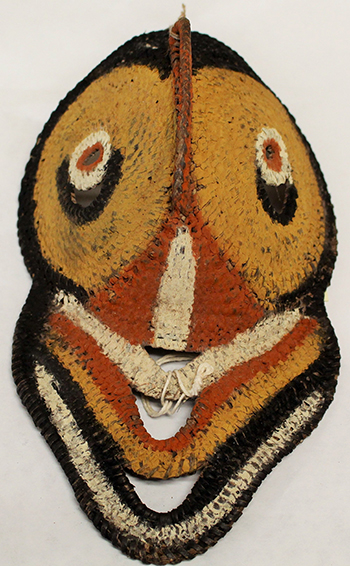Yam Mask
 The population of Papua New Guinea is one of the most diverse in the world. There are more than 800 languages spoken, and many small communities have developed unique customs and traditions. This yam mask comes from the Saragum #2 village in the Maprik area of the East Sepik Province. In this area of the country, the cultivation of long yams, which can grow to a length of 12 feet, is a core element of ceremonial life. These yams have a purely ritual purpose and are not meant to be eaten. Following the harvest, an extravagant ceremony takes place during which each man exchanges the yams he has grown with those of a permanent partner. The man who is able to repeatedly offer yams longer than those that he receives gains great social status. For the exchange ceremony, the yams are outfitted as men in full ritual costume including masks like this one. The masks are designed specifically for the yams and are not worn by people. Constructed of woven plant fiber, similar to a basket, the masks are colored with clay pigments. This yam mask is in form known as beak style, in which the human face is represented with a long nose similar to the beak of a bird.
The population of Papua New Guinea is one of the most diverse in the world. There are more than 800 languages spoken, and many small communities have developed unique customs and traditions. This yam mask comes from the Saragum #2 village in the Maprik area of the East Sepik Province. In this area of the country, the cultivation of long yams, which can grow to a length of 12 feet, is a core element of ceremonial life. These yams have a purely ritual purpose and are not meant to be eaten. Following the harvest, an extravagant ceremony takes place during which each man exchanges the yams he has grown with those of a permanent partner. The man who is able to repeatedly offer yams longer than those that he receives gains great social status. For the exchange ceremony, the yams are outfitted as men in full ritual costume including masks like this one. The masks are designed specifically for the yams and are not worn by people. Constructed of woven plant fiber, similar to a basket, the masks are colored with clay pigments. This yam mask is in form known as beak style, in which the human face is represented with a long nose similar to the beak of a bird.
Other objects from Papua New Guinea that have been featured for Artifact of the Month include a palm spathe, a flute, a dog tooth necklace, a mud mask, and a cassowary bone dagger.

